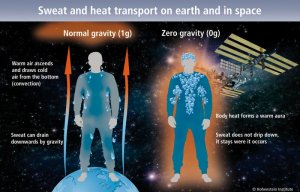
Hohenstein presents Spacetex update
On 28 May 2014, the six-month Blue Dot space mission lifts off. A German astronaut from ESA will be among those on board the International Space Station ISS, who will be carrying out about 40 experiments. These will include the Specatex project, the first clothing physiology experiments to be carried out in weightlessness, which it is hoped will shed light on the interaction between body, clothing and climate.

14th March 2014
Innovation in Textiles
|
Boennigheim
On 28 May 2014, the six-month Blue Dot space mission lifts off. A German astronaut from ESA will be among those on board the International Space Station ISS, who will be carrying out about 40 experiments.
These will include the Specatex project, the first clothing physiology experiments to be carried out in weightlessness, which it is hoped will shed light on the interaction between body, clothing and climate.
The Specatex research partners are the Hohenstein Institute (Boennigheim, Germany), Schoeller Textil AG (Sevelen, Switzerland), the Charité medical school (Berlin, Germany), DLR (Bonn/Bremen, Germany) and ESA/ESTEC (Cologne/Noordwijk, Germany/Netherlands). Partners are hoping to make all kinds of findings from the joint undertaking.
Firstly, the tests should deliver essential information for developing new textile products for use in extreme climatic and physiological conditions on Earth.
Secondly, the data that is obtained should help to optimise astronauts' clothing for future visits to space and long-term missions, such as the approximately three-year voyage to Mars that is planned for 2030.
Project leader Dr Jan Beringer of the Hohenstein Institute commented: “Among other things, the lack of gravity affects the way body heat and sweat are transported away through clothing that is worn next to the skin. To ensure that the body's cooling mechanism is still properly maintained, textiles have to be specially adapted for use in space.”
Prof Hanns-Christian Gunga of the Charité medical school has spent years studying the effects that spending time in weightlessness in space or in extreme climatic conditions on Earth has on the human body: “In zero gravity, the breakdown of muscle and bone tissue begins very quickly. To counteract that degeneration, working on special training equipment is extremely important for the astronauts.”
In addition to their potential future use in space, space-proofed textiles are also of great interest with regard to extreme conditions here on Earth.
For Hans-Jürgen Hübner of Schoeller, this is an important reason why the textile manufacturer is involved in this industry-funded research project: “We will feed the findings from the Specatex project into our product development and optimisation work. Not only will future astronauts benefit from them but also people here on Earth who go to the limits of their physical endurance or have to deliver peak performance in extreme ambient conditions.”

Business intelligence for the fibre, textiles and apparel industries: technologies, innovations, markets, investments, trade policy, sourcing, strategy...
Find out more